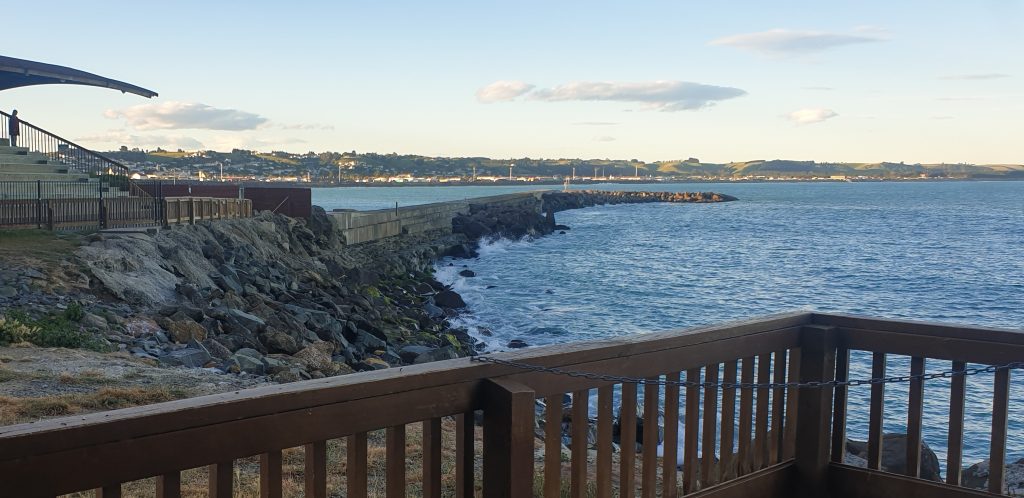Everyone sits still in the dusk light – the spot lit up only with an amber glow, that blue penguins can’t see. The sole sound is that of the sea crashing onto the rocks below. We’ve been told not to move or speak, to allow the penguins to easily find their way back home.
We’re at Oamaru’s Blue Penguin Colony, a site that exists thanks to a blend of natural nesting and conservation efforts. Originally, a few penguins were spotted nesting in a disused quarry back in the 1990s. To help them breed, the site was cleaned of predators and hazards, nests were supported, and access was restricted.
Since then, the penguins have happily multiplied – over 200 now call the site home. They go out to fish during the day and return en masse when it’s dark, to feed their young. To help with conservation efforts, viewing is open to a small group of people daily from designated stands.

When heads are first spotted out at sea, bobbing up and down, a ripple goes through the crowd. Everyone’s neck cranes right, as we follow the journey of the little dots coming rapidly closer and closer. They’re surprisingly quick – within seconds, the first group is upon us, clambering and slithering up the beach’s rocks, keeping an eye on each other as they climb up. Some surf the waves, using them to clear a few rocks.
They’re not the stereotypical penguin. Blue-gray with white bellies – they’re about the size of an A4 sheet. In fact, blue penguins are the smallest species of penguin known, found only in New Zealand and Australia. (Scientific name: Eudyptula minor)
Booking.comDripping wet, feathers all slicked back, a lookout group peeks over the top of the rocks to check that the coast is clear. Then, they quickly waddle to three holes that lead to their nesting system. Their bellies are full of fish to feed their young, and it’s easy to see that some have brought more food home than others. These penguins lag behind, struggling to put one flipper in front of the other.
The rest of the group comes over the rocks in subdivisions, and the pattern repeats itself, each with its own stragglers. As the penguins reach their nests, cries of their young fill the air. The chicks are about to get some regurgitated fish to fill up their own bellies.
Just when the show seems to be over, another group (known officially as a raft) is spotted bobbing up and down in the water. The penguins continue coming in waves, and follow the same pattern. But it’s not a sight that one can get easily bored of.
We stay still it’s closing time, five rafts later. As we’re leaving, the site attendant tells us to drive slowly and watch out for penguins on the road. He says it with a smile, so we assume he’s joking. But as we walk out we spot two, then another three, then another group of three.
Our car is far away and, as we walk along, it’s clear that there are quite a few confused penguins about. We stay as silent as possible, watching our own private show. Two waddle right up to us and we hold our breath, remaining stock still, not wanting to be the reason they don’t make it safely back home. After a few priceless seconds, they waddle on.
Top tips for visiting Oamaru’s Blue Penguins
- Oamaru’s Blue Penguin Colony offers both day and evening viewing, but evening is where the show is at, as that’s when the penguins come back from their day out fishing. Two ticket types are offered: regular seating and premium. Premium will get you much closer to the penguins. Both fill up quickly, so make sure to book this in advance online.
- Spend the night in Oamaru itself, rather than making the trip back to Dunedin as many seem to do. Oamaru is a quirky Victorian hotspot and well worth a night’s stay. We spent the night in Poshtel and loved it – every room is different and based on a particular aspect of Oamaru’s history.
- Photography of the penguins is not allowed, except with special permission. This protects the penguins, reducing light and and movement that could otherwise distract them from reaching their nests. (Hence the single video in this post, taken continuously at bench-level.)
- The site gets very chilly in the evening, even in the height of summer, so wrap up warm for a visit. You’ll be seated for a while.
- For more on my travels around New Zealand, see my New Zealand road trip itinerary.